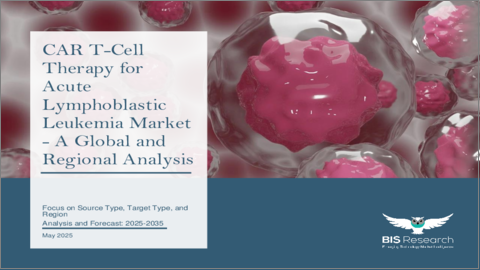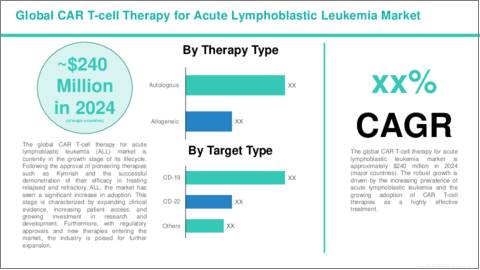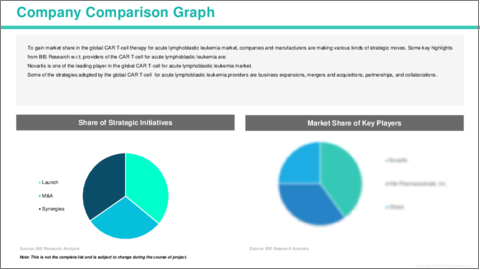|
|
市場調査レポート
商品コード
1729045
急性リンパ性白血病のCAR T細胞療法市場- 世界および地域別分析:由来タイプ別、標的タイプ別、地域別 - 分析と予測(2025年~2035年)CAR T-Cell Therapy for Acute Lymphoblastic Leukemia Market - A Global and Regional Analysis: Focus on Source Type, Target Type, and Region - Analysis and Forecast, 2025-2035 |
||||||
カスタマイズ可能
|
|||||||
| 急性リンパ性白血病のCAR T細胞療法市場- 世界および地域別分析:由来タイプ別、標的タイプ別、地域別 - 分析と予測(2025年~2035年) |
|
出版日: 2025年05月21日
発行: BIS Research
ページ情報: 英文 100 Pages
納期: 1~5営業日
|
全表示
- 概要
- 図表
- 目次
世界の急性リンパ性白血病のCAR T細胞療法市場は、現在ライフサイクルの成長段階にあります。
Kymriahのような先駆的治療薬が承認され、再発難治性ALLの治療における有効性が実証されたことを受けて、市場は大幅な普及を見せています。この段階の特徴は、臨床エビデンスの拡大、患者アクセスの増加、研究開発への投資の拡大です。さらに、規制当局の承認や新たな治療法の市場参入により、業界はさらなる拡大に向かっています。しかし、高額な治療費、製造の複雑さ、長期的な安全性データの必要性といった課題は依然として残っています。こうした障害にもかかわらず、市場は、治療法の革新、戦略的パートナーシップ、次世代CAR T細胞療法の継続的開発によって力強い成長を遂げています。
影響
- 急性リンパ性白血病治療のためのCAR T細胞療法に対する需要の増加は、予測期間の2025年~2035年の間、市場の成長を支えると予想されます。
- 世界の急性リンパ性白血病のCAR T細胞療法市場は、診断技術の進歩、革新的な治療法の市場開拓、患者やヘルスケア提供者の意識の高まりにより、大きな成長が見込まれています。
北米は、高度なヘルスケアインフラ、有病率の高さ、疾患に対する認識の高まりから、予測期間中、世界の急性リンパ性白血病のCAR T細胞療法市場を独占すると予想されます。同地域はまた、規制上の利点や強力な製薬会社の存在もあり、効果的な治療法の利用を促進し、世界の急性リンパ性白血病のCAR T細胞療法市場の成長を牽引しています。
最近の動向
- 規制活動:2025年3月、小児および成人の再発/難治性T-ALL/LBL患者を対象としたCTD402のIND申請がFDAにより承認され、単群非盲検第1b/2相試験が開始されました。
- 規制当局の活動2024年11月、FDAはAutolus TherapeuticsのCAR-T細胞治療薬AUCATZYLについて、成人r/r型B-ALL患者の治療薬として販売承認を与えました。
需要- 促進要因と限界
急性リンパ性白血病に対する世界のCAR T細胞療法市場の促進要因は以下の通りです:
- 急性リンパ性白血病の有病率の上昇
- 製造およびプロセス改善における進歩
- 地域ごとに承認された強固な製品パイプライン
世界の急性リンパ性白血病のCAR T細胞療法市場は、以下の課題により、いくつかの制約にも直面すると予想されます:
- 高い治療費
製品/イノベーション戦略:世界の急性リンパ性白血病のCAR T細胞療法市場における製品上市と技術革新は、患者の治療を改善するための治療選択肢の進展に焦点を当てています。これらのイノベーションは、治療の有効性を高め、疾患の発見と管理を合理化することを目的としています。Autolus Therapeuticsをはじめとする市場の主な参入企業は、急性リンパ性白血病に対するCAR T細胞療法の治療開発に関わってきました。
競合戦略:世界の急性リンパ性白血病のCAR T細胞療法市場におけるリーダー企業は、競争力を維持するために、革新的な治療法で製品ポートフォリオの更新に継続的に取り組んでいます。急性リンパ性白血病を対象としたCAR T細胞療法の世界市場における主要企業の詳細な競合ベンチマーキングを実施し、製品提供、市場シェア、技術革新の点でこれらの企業がどのように比較しているかについての競合考察を提供します。このベンチマーキングにより、読者は市場情勢と主要企業のポジションを明確に理解することができます。さらに、パートナーシップ、契約、提携などの包括的な競合戦略は、読者が市場で未開拓の収益機会を特定するのに役立ちます。
主要市場参入企業と競合の要約
企業プロファイルは、一次専門家から収集したインプットに基づき、企業カバレッジ、製品ポートフォリオ、市場浸透度を分析することで選定しています。
主要企業には、急性リンパ性白血病のCAR T細胞療法プロバイダーが含まれ、世界の急性リンパ性白血病のCAR T細胞療法市場の約95%を占めています。
当レポートでは、世界の急性リンパ性白血病のCAR T細胞療法市場について調査し、市場の概要とともに、由来タイプ別、標的タイプ別、地域別の動向、および市場に参入する企業のプロファイルなどを提供しています。
目次
エグゼクティブサマリー
調査範囲
第1章 世界の急性リンパ性白血病のCAR-T細胞療法市場:市場見通し
- 業界展望
- 市場力学
第2章 世界の急性リンパ性白血病のCAR-T細胞療法市場(由来タイプ別、100万米ドル、2023年~2035年)
- 自家移植
- 同種異系
第3章 世界の急性リンパ性白血病のCAR-T細胞療法市場、標的タイプ別、100万米ドル、2023年~2035年
- CD-19
- CD-22
- その他
第4章 世界の急性リンパ性白血病のCAR-T細胞療法市場、地域別、100万米ドル、2023年~2035年
- 北米
- 欧州
- アジア太平洋
第5章 世界の急性リンパ性白血病のCAR-T細胞療法市場-競合ベンチマーキングと企業プロファイル
- 競合情勢
- 各社の主要戦略と展開
- 主な発展分析
- 企業プロファイル
- Novartis AG
- Autolus Therapeutics
- Gilead Sciences
- OneChain Immunotherapeutics
- Cellectis S.A.
- Wugen, Inc.
- Bioheng Therapeutics
第6章 調査手法
List of Figures
- Figure: Global CAR T-Cell Therapy for Acute Lymphoblastic Leukemia Market, Market Overview
- Figure: Global CAR T-Cell Therapy for Acute Lymphoblastic Leukemia Market, Epidemiological Analysis, U.S.
- Figure: Global CAR T-Cell Therapy for Acute Lymphoblastic Leukemia Market Coverage
- Figure: Global CAR T-Cell Therapy for Acute Lymphoblastic Leukemia Market Key Trends, Impact Analysis, 2023-2035
- Figure: Global CAR T-Cell Therapy for Acute Lymphoblastic Leukemia Market, Competitive Landscape, January 2022-April 2025
List of Tables
- Table: Global CAR T-Cell Therapy for Acute Lymphoblastic Leukemia Market, Regulatory Scenario
- Table: Global CAR T-Cell Therapy for Acute Lymphoblastic Leukemia Market Dynamics, Impact Analysis
- Table: Global CAR T-Cell Therapy for Acute Lymphoblastic Leukemia Market (by Source Type), $Million, 2023-2035
- Table: Global CAR T-Cell Therapy for Acute Lymphoblastic Leukemia Market (by Target Type), $Million, 2023-2035
- Table: Global CAR T-Cell Therapy for Acute Lymphoblastic Leukemia Market (by Region), $Million, 2023-2035
Market Lifecycle Stage
The global CAR T-cell therapy for acute lymphoblastic leukemia market is currently in the growth stage of its lifecycle. Following the approval of pioneering therapies such as Kymriah and the successful demonstration of their efficacy in treating relapsed and refractory ALL, the market has seen a significant increase in adoption. This stage is characterized by expanding clinical evidence, increasing patient access, and growing investment in research and development. Furthermore, with regulatory approvals and new therapies entering the market, the industry is poised for further expansion. However, challenges such as high treatment costs, manufacturing complexities, and the need for long-term safety data remain. Despite these obstacles, the market is experiencing robust growth driven by innovations in therapy, strategic partnerships, and the ongoing development of next-generation CAR T-cell therapies.
Impact
- Increasing demand for CAR T-cell therapy for acute lymphoblastic leukemia therapies is anticipated to support the growth of the global CAR T-cell therapy for acute lymphoblastic leukemia market during the forecast period 2025-2035.
- The global CAR T-cell therapy for acute lymphoblastic leukemia market is expected to grow at a significant rate due to advancements in diagnostic technologies, the development of innovative therapies, and increasing awareness among patients and healthcare providers.
Market Segmentation:
Segmentation 1: by Source Type
- Autologous
- Allogeneic
Segmentation 2: by Target Type
- CD19
- CD22
- Others
Segmentation 3: by Region
- North America
- Europe
- Asia-Pacific
- Rest-of-the-World
North America is expected to dominate the global CAR T-cell therapy for acute lymphoblastic leukemia market during the forecast period due to its advanced healthcare infrastructure, high prevalence of disease, and increased awareness of the disease. The region also benefits from regulatory advantages and a strong pharmaceutical presence, which accelerates the availability of effective treatments and drives the growth of the global CAR T-cell therapy for acute lymphoblastic leukemia market.
Recent Developments:
- Regulatory Activities: In March 2025, the FDA approved the IND application for CTD402 for treating pediatric and adult patients with relapsed/refractory T-ALL/LBL, which enabled the commencement of a single-arm, open-label phase 1b/2 trial.
- Regulatory Activities: In November 2024, the FDA granted marketing approval for Autolus Therapeutics' CAR-T cell therapy, AUCATZYL, for the treatment of adult patients with r/r B-ALL.
Demand - Drivers and Limitations
The following are the drivers for the global CAR T-cell therapy for acute lymphoblastic leukemia market:
- Rising Prevalence of Acute Lymphoblastic Leukemia
- Advancements in Manufacturing and Process Improvements
- Robust Product Pipeline with Regulatory Approvals Across Geographies
The global CAR T-cell therapy for acute lymphoblastic leukemia market is expected to face some limitations too, due to the following challenges:
- High Treatment Costs
How Can This Report Add Value to an Organization?
Product/Innovation Strategy: Product launches and innovations in the global CAR T-cell therapy for acute lymphoblastic leukemia market are focused on advancing treatment options to improve patient care. These innovations aim to enhance the efficacy of therapies and streamline the detection and management of the disease. Key players in the market, such as Autolus Therapeutics, have been involved in the development of therapies for CAR T-cell therapy for acute lymphoblastic leukemia.
Competitive Strategy: Enterprises led by market leaders in the global CAR T-cell therapy for acute lymphoblastic leukemia market are continuously working on updating their product portfolios with innovative treatments to maintain competitiveness. A detailed competitive benchmarking of the key players in the global CAR T-cell therapy for acute lymphoblastic leukemia market has been conducted, providing insights into how these companies compare in terms of product offerings, market share, and innovation. This benchmarking provides readers with a clear understanding of the market landscape and the positions of the leading players. Additionally, comprehensive competitive strategies, such as partnerships, agreements, and collaborations, will help readers identify untapped revenue opportunities in the market.
Key Market Players and Competition Synopsis
The companies that are profiled have been selected based on inputs gathered from primary experts and by analyzing company coverage, product portfolio, and market penetration.
The top segment players include CAR T-cell therapy for acute lymphoblastic leukemia therapy providers that capture around 95% of the global CAR T-cell therapy for acute lymphoblastic leukemia market.
Some of the prominent names established in this market are:
- Autolus Therapeutics
- Bioheng Therapeutics
- Cellectis S.A.
- Gilead Sciences
- Novartis AG
- Wugen, Inc.
- OneChain Immunotherapeutics
Table of Contents
Executive Summary
Scope of Study
1. Global CAR T-Cell Therapy for Acute Lymphoblastic Leukemia Market: Market Outlook
- 1.1 Industry Outlook
- 1.1.1 Market Overview and Ecosystem
- 1.1.2 Key Trends
- 1.1.3 Epidemiological Analysis of Acute Lymphoblastic Leukemia
- 1.1.3.1 By Region
- 1.1.4 Clinical Trials
- 1.1.4.1 By Phase
- 1.1.4.2 By Sponsor Type
- 1.1.5 Regulatory Landscape / Compliance
- 1.1.5.1 Legal Requirement and Framework in the U.S.
- 1.1.5.2 Legal Requirement and Framework in the E.U.
- 1.1.5.3 Legal Requirement and Framework in Japan
- 1.1.5.4 Legal Requirement and Framework in Rest-of-the-World
- 1.2 Market Dynamics
- 1.2.1 Impact Analysis
- 1.2.2 Market Drivers
- 1.2.3 Market Restraints
- 1.2.4 Market Opportunities
2. Global CAR T-Cell Therapy for Acute Lymphoblastic Leukemia Market, By Source Type, $Million, 2023-2035
- 2.1 Autologous
- 2.2 Allogeneic
3. Global CAR T-Cell Therapy for Acute Lymphoblastic Leukemia Market, By Target Type, $Million, 2023-2035
- 3.1 CD-19
- 3.2 CD-22
- 3.3 Others
4. Global CAR T-Cell Therapy for Acute Lymphoblastic Leukemia Market, By Region, $Million, 2023-2035
- 4.1 North America
- 4.1.1 Key Findings
- 4.1.2 Market Dynamics
- 4.1.3 Market Sizing and Forecast
- 4.1.3.1 U.S. CAR T-Cell Therapy for Acute Lymphoblastic Leukemia Market (by Country)
- 4.1.3.1.1 U.S.
- 4.1.3.1 U.S. CAR T-Cell Therapy for Acute Lymphoblastic Leukemia Market (by Country)
- 4.2 Europe
- 4.2.1 Key Findings
- 4.2.2 Market Dynamics
- 4.2.3 Market Sizing and Forecast
- 4.2.3.1 Europe CAR T-Cell Therapy for Acute Lymphoblastic Leukemia Market (by Country)
- 4.2.3.2 U.K.
- 4.2.3.3 Germany
- 4.2.3.4 France
- 4.2.3.5 Italy
- 4.3 Asia-Pacific
- 4.3.1 Key Findings
- 4.3.2 Market Dynamics
- 4.3.3 Market Sizing and Forecast
- 4.3.3.1 Asia-Pacific CAR T-Cell Therapy for Acute Lymphoblastic Leukemia Market (by Country)
- 4.3.3.2 China
- 4.3.3.3 Japan
5. Global CAR T-Cell Therapy for Acute Lymphoblastic Leukemia Market - Competitive Benchmarking and Company Profiles
- 5.1 Competitive Landscape
- 5.1.1 Key Strategies and Developments by Company
- 5.1.1.1 Funding Activities
- 5.1.1.2 Mergers and Acquisitions
- 5.1.1.3 Regulatory Approvals
- 5.1.1.4 Partnerships, Collaborations and Business Expansions
- 5.1.2 Key Developments Analysis
- 5.1.1 Key Strategies and Developments by Company
- 5.2 Company Profiles
- 5.2.1 Novartis AG
- 5.2.1.1 Company Overview
- 5.2.1.2 Product Portfolio
- 5.2.1.3 Target Customers/End Users
- 5.2.1.4 Analyst View
- 5.2.2 Autolus Therapeutics
- 5.2.2.1 Company Overview
- 5.2.2.2 Product Portfolio
- 5.2.2.3 Target Customers/End Users
- 5.2.2.4 Analyst View
- 5.2.3 Gilead Sciences
- 5.2.3.1 Company Overview
- 5.2.3.2 Product Portfolio
- 5.2.3.3 Target Customers/End Users
- 5.2.3.4 Analyst View
- 5.2.4 OneChain Immunotherapeutics
- 5.2.4.1 Company Overview
- 5.2.4.2 Product Portfolio
- 5.2.4.3 Target Customers/End Users
- 5.2.4.4 Analyst View
- 5.2.5 Cellectis S.A.
- 5.2.5.1 Company Overview
- 5.2.5.2 Product Portfolio
- 5.2.5.3 Target Customers/End Users
- 5.2.5.4 Analyst View
- 5.2.6 Wugen, Inc.
- 5.2.6.1 Company Overview
- 5.2.6.2 Product Portfolio
- 5.2.6.3 Target Customers/End Users
- 5.2.6.4 Analyst View
- 5.2.7 Bioheng Therapeutics
- 5.2.7.1 Company Overview
- 5.2.7.2 Product Portfolio
- 5.2.7.3 Target Customers/End Users
- 5.2.7.4 Analyst View
- 5.2.1 Novartis AG






